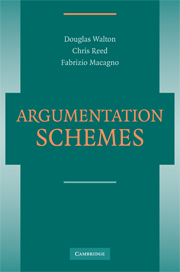Book contents
- Frontmatter
- Contents
- Acknowledgments
- Introduction
- 1 Basic Tools in the State of the Art
- 2 Schemes for Argument from Analogy, Classification, and Precedent
- 3 Knowledge-Related, Practical, and Other Schemes
- 4 Arguments from Generally Accepted Opinions, Commitment, and Character
- 5 Causal Argumentation Schemes
- 6 Schemes and Enthymemes
- 7 Attack, Rebuttal, and Refutation
- 8 The History of Schemes
- 9 A User's Compendium of Schemes
- 10 Refining the Classification of Schemes
- 11 Formalizing Schemes
- 12 Schemes in Computer Systems
- Bibliography
- Index
10 - Refining the Classification of Schemes
Published online by Cambridge University Press: 05 June 2012
- Frontmatter
- Contents
- Acknowledgments
- Introduction
- 1 Basic Tools in the State of the Art
- 2 Schemes for Argument from Analogy, Classification, and Precedent
- 3 Knowledge-Related, Practical, and Other Schemes
- 4 Arguments from Generally Accepted Opinions, Commitment, and Character
- 5 Causal Argumentation Schemes
- 6 Schemes and Enthymemes
- 7 Attack, Rebuttal, and Refutation
- 8 The History of Schemes
- 9 A User's Compendium of Schemes
- 10 Refining the Classification of Schemes
- 11 Formalizing Schemes
- 12 Schemes in Computer Systems
- Bibliography
- Index
Summary
It would be very helpful for users of the schemes to have a more refined system of classification, so that the user could search through to find a scheme applicable to her needs in a given case by searching under other, more general ones where the particular scheme being sought is known to fit. It is already fairly evident from the compendium of schemes that some schemes fit under others as subspecies of them. For example, one of the most common schemes is argument from consequences. It is closely related to practical reasoning. Other schemes, like those for the slippery slope argument, often fit under the category of argument from consequences. However, such classifications are not as straightforward as they initially seem. For example, some slippery slope arguments fit under the category of arguments from precedent, and therefore may not fit the scheme of argument from consequences, at least in any straightforward way. Another very common scheme under which many others fit as subspecies is the scheme for argument from commitment. Here we have a cluster of schemes that are closely related to each other, but in complex ways. Schemes that are very general, like those for argument from consequences and argument from ignorance, are related to many other, more specific schemes that fall under them. This chapter sets us on the road to beginning the research project of taking such clusters of schemes and investigating how they fit together with their neighboring schemes.
- Type
- Chapter
- Information
- Argumentation Schemes , pp. 347 - 363Publisher: Cambridge University PressPrint publication year: 2008



